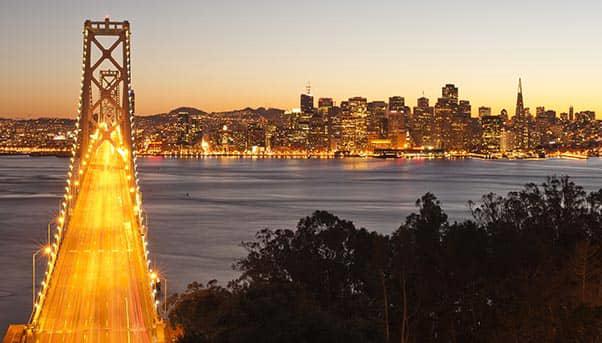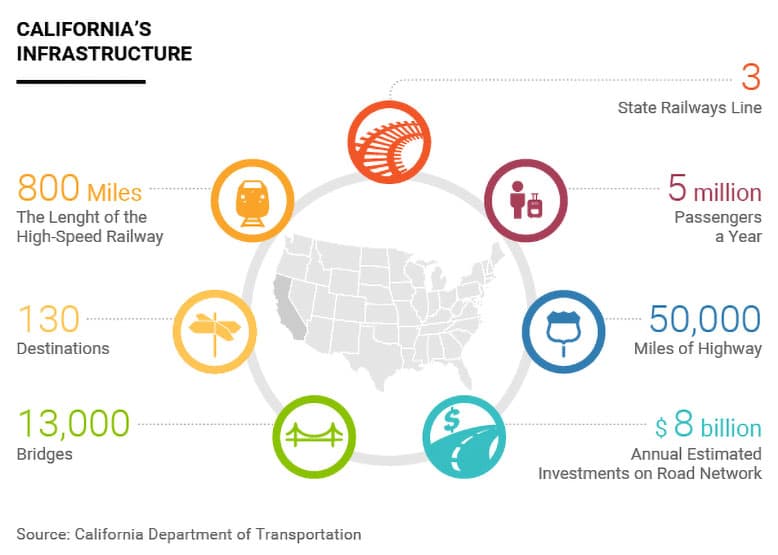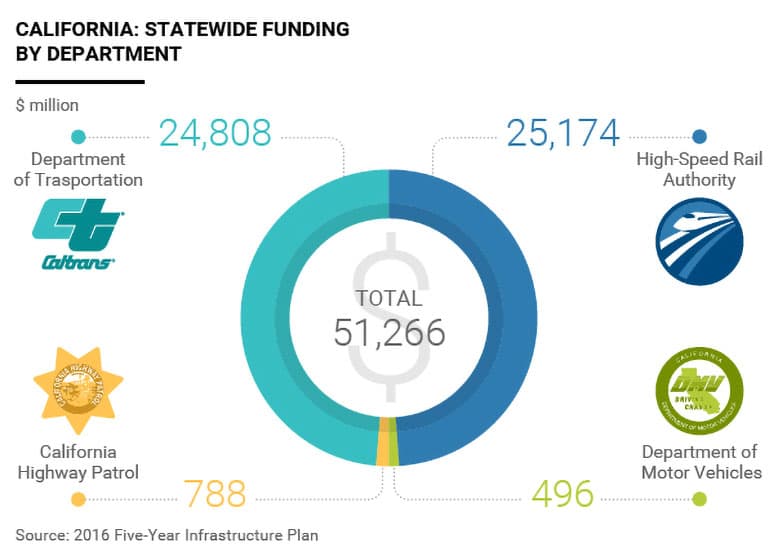
The word “infrastructure” evokes so many things in California: the highways of Los Angeles and the Golden Gate Bridge of San Francisco, to name a few. Such has been their contribution to development that they have become symbols of the richest state in the United States. Indeed, California would be the fifth economy in the world if its gross domestic product (GDP) were calculated independently of the rest of the country.
The bridge and the highways recall the construction boom of the 1950s and 1960s that accompanied the state’s economic growth. The boom gave the state 50,000 miles of highway, 13,000 bridges and three state railway lines that carry five million passengers a year to 130 destinations. This infrastructure is crucial to support a population that, according to state officials, will grow from 40 million to 50 million by 2050.
Keeping it in good shape and expanding it when necessary is part of the state’s agenda. With President-elect Donald Trump’s plan to invest $1 trillion in the sector across the country, the importance of its role in keeping the economy growing is very clear. Reaction to his plan from states like California was immediate.

$6 Billion for Roads
Early in 2017, California state Senator Jim Beall and Assembly Member Jim Frazier will be presenting to the state’s legislative body for debate a bill to invest $6 billion in transport infrastructure – in addition to $55 billion to be earmarked under a recently announced five-year plan. «Without action soon, our crumbling roads will severely affect California’s economy» Beall was quoted as saying.
Beall and Frazier propose raising the funds from motorists, especially truck drivers who use the state’s highway network more than any other. So a good part of the $6 billion could come from a 12% increase in the gas tax and a 20% increase in the diesel tax. This measure alone would bring $3.8 billion into state coffers. Other measures could include an annual vehicle registration fee or one on CO2 emissions. As the bill waits to be debated in the state legislature, California has already prepared a series of massive investments for the sector under a recently approved five-year plan.
The Five-Year Infrastructure Plan
In 2016, State Governor Edmund G. Brown Jr. signed the Five-Year Infrastructure Plan that foresees $55 billion of investments. Nearly all of the initiatives outlined in the plan is dedicated to transport such as roads and railways. In addition to maintenance and development of the road and highway network, there is a project to build the first high-speed train in the United States.
But it needs to find the funds to do it. Between 1974 and 1999, Californian voters approved the bond issues for a total of $38.3 billion. From 2000 to the present day, this way of financing infrastructure development has grown, with the value of bond issues reaching a combined total of $103 billion since 1974.

California’s Road Network
The road network, which has served the state well as its population and economy has grown during the past decades, is so extensive that the State Highway Operation and Protection Program, which manages investment in the sector, estimates that $8 billion is needed to be spent every year to keep it in shape.
In response, the state governor has set aside $36 billion of his five-year plan for this purpose – but the amount will be spent in 10 rather than five years. Of this amount, $16.2 billion will got to highways, $13.5 billion to local roads, $2.3 billion to trade corridors and $4 billion to the state railway system, excluding the high-speed train line at this stage.
Sustainable Infrastructure
But this development must take into account the environment and make the most to protect it. California is one of the U.S. states most involved in the fight against air pollution. On April 2015, Governor Brown Jr. signed Executive Order B-30-15 to oblige every state agency to take into consideration climate change, as indicated in the five-year plan. «Future investments in state buildings, water systems, and transportation infrastructure, including roads and railways, will be made with a changing climate in mind.»
The goal is to reduce by 40% CO2 emissions by 2030 compared with levels recorded in 1990. This sensibility to the environment is central to the biggest project being undertaken in California: the construction of the first high-speed train line in the United States. Once completed, it will run solely on renewable energy.
California’s Fast Train
The line would be 800 miles long with 24 stations, 150,000 bridges, viaducts and elevated structures as well as 35,000 tunnels. It would link San Francisco with Los Angeles and could eventually extend its reach to San Diego and Sacramento. Nearly all residents in the state would be close enough to the line to use it.
It is set to be completed by 2029. The High-Speed Rail Authority is managing the project after receiving the first $9 billion in 2008. The five-year plan approved by the governor in 2016 foresees another $25.2 billion for the project. But news reports from the likes of Bloomberg and the Los Angeles Times say the amount is not enough, that the cost could reach $68 billion, more than double the $33 billion previously estimated.

